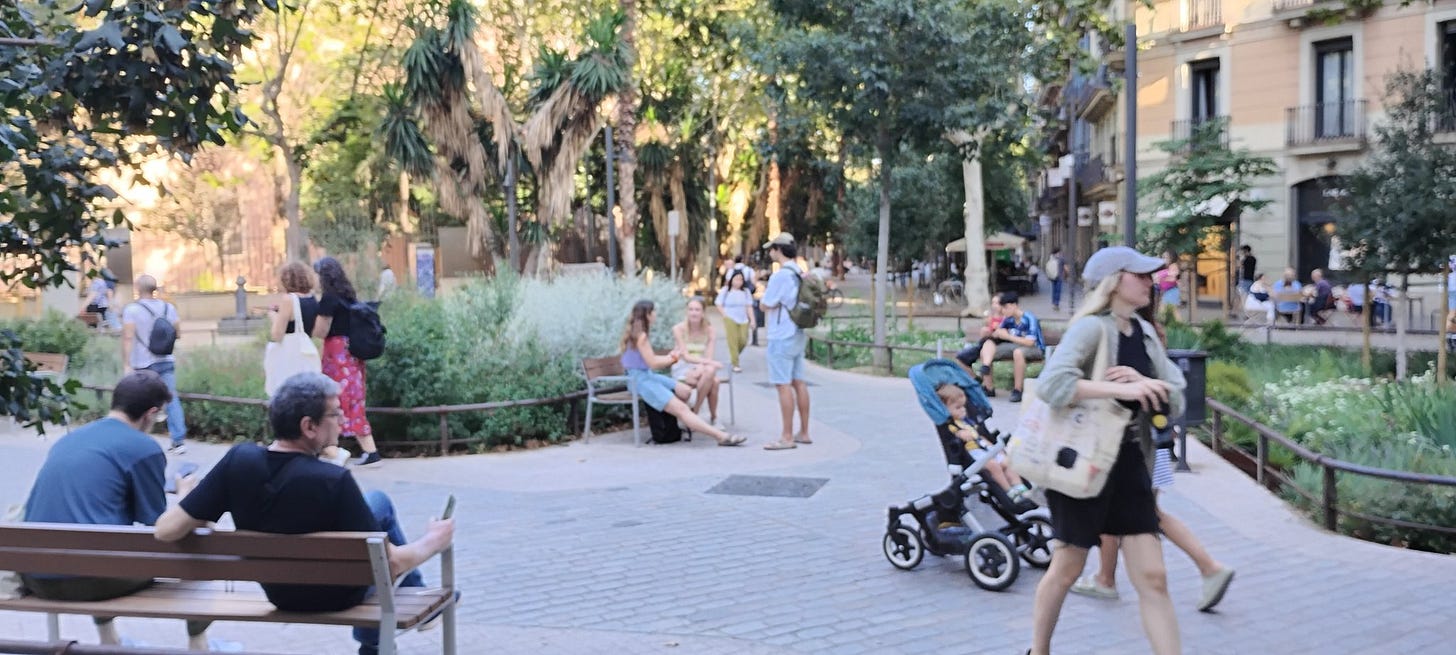Last summer I traveled to Barcelona to experience their new pedestrian spaces and protected bike network firsthand. Francesc Magrinya Torner, a professor of urban planning at the Technical University of Catalognia, was kind enough to take me on a 4 hour bike ride through the streets of Barcelona. Francesc knew all the projects to take me to since he helped design many of them. He was also Director of the Strategic Planning Department of the Metropolitan Area of Barcelona and did in-depth research on the public health impacts of street closures and pedestrian spaces.
Many planners and engineers focus on traffic safety arguments when advocating for pedestrian and bicycle infrastructure, but Barcelona took a different angle that seemed to resonate with the public just as effectively: Public health.
According to data from the Public Health Agency of Barcelona, every year there are a thousands of premature deaths due to pollution in the city, which represents 7% of the annual deaths in the city. In addition, 33% of new cases of childhood asthma (525 each year) and 11% of new cases of lung cancer (110 each year) are attributable to poor air quality in Barcelona. - Agència de Barcelona Public Health, 2020
Barcelona began closing off local streets to through traffic at regular intervals on their street grid in the 2010s. The Superblock model, first piloted in the Poblenou neighborhood in 2016, was a game-changer. Each Superblock spans nine square blocks of the grid street network, with interior streets restricted to residents and deliveries (capped at 10 km/h), while traffic is rerouted to perimeter roads. By 2022, Barcelona had rolled out five full Superblocks and dozens of smaller interventions. These streets were redesigned with pavers, new trees, bioswales, outdoor seating and other amenities. Deliveries are still allowed at certain times of the day using retractable bollards. After construction, a 33% reduction in NO2 and 4% reduction in PM10 was seen at the Borrell/Tamarit junction in the Sant Antoni neighborhood. A 4 to 6 dB noise reduction was seen at certain locations as well. Childhood asthma rates and ER visits also declined. Tying the pedestrianization of streets to pollution and public health outcomes was a stroke of genius and helped solidify community and political support for the projects.
A partnership between community advocates and the public sector led the bottom-up approach to building out a pedestrian network. Designating through streets that wrapped around the pedestrian-focused Superblocks created contiguous spaces for people to enjoy while reducing emissions in residential areas. When I asked Mr. Torner if there’s one applicable lesson from Barcelona we can apply in the U.S,, he said getting the support of neighborhood groups, non-profits and other advocates is key. None of their pedestrianized streets would have been built without community support.
Economically, the Superblocks paid off too. A 2024 study by the Barcelona Chamber of Commerce found that retail revenue in pedestrianized zones rose 15-20% within two years of conversion, as foot and bike traffic spiked. Cafes and small shops saw the biggest gains, with outdoor seating areas drawing crowds. Property values near Superblocks climbed 8% faster than in car-heavy zones, per real estate firm CBRE Spain.
While these new spaces were being created, the city was also building out its bike network to compliment the new Superblocks. Bike traffic in 2023 saw a 23% increase compared 2019, with an expansive 200 mile bike network in 2025. I saw firsthand how much of this network consisted of cycletracks and protected bike lanes, even on arterial streets. Cyclists almost never have to share the road with fast moving traffic. Cycling around Barcelona also showed me the power of “armadillo” separators. Many bike lanes were separated from traffic with these devices, and while they don’t seem like substantial vertical separation, they kept vehicles in their lanes and out of bike lanes. Protected cycling routes were also direct and on major commercial streets, like Gran Via de les Corts Catalanes. The city understood that cyclists want direct routes just like drivers do, and they spend just as much money (if not more) during their trips as drivers. Cyclists tend to visit shops more frequently, leading to higher overall expenditures over time.
The combination of new pedestrian spaces and an expansive bike network work together to create a seamless network that allows people to be independent from daily automobile use. The infrastructure tangibly improved the quality of life in the city, too. A 2024 Eurobarometer survey ranked Barcelona’s livability at 87/100, up 10 points since 2015, with 62% of residents citing cleaner air and quieter streets. Car use dropped 12% citywide since 2019, per traffic counts,
A combination of top-down political forces and bottom-up community support helped transform Barcelona. Realizing that the city had too many streets that were choked with traffic that negatively impacted the health of residents, Barcelona decided to act. But is this transformation applicable to the U.S., a country that has a much higher driving rate and more entrenched automobile interests? Some would argue no. Barcelona already started off with a lower car ownership rate, better infrastructure “bones” with their pedestrian friendly, Cerdà-designed blocks, and a relatively massive subway that created a true alternative to driving. This doesn’t mean U.S. shouldn’t seek to emulate Barcelona’s success, but being aware of infrastructural and cultural differences can go a long way in adapting success stories like these to American cities.
Presentation: Lessons from the Superblocks in Barcelona: What next? SUPERBLOCK BARCELONA WORKSHOP: LESSONS LEARNED AND WHAT IS NEXT? 19 JUNE 2024. ICTA










Let me know next time you're in town, we can do another bike ride!
Thanks for sharing!